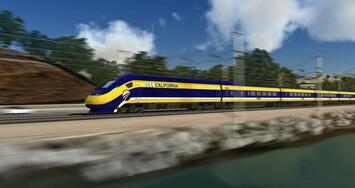
Curiouser and curiouser, said Alice as she grew taller and taller in Wonderland.
Curiouser and curiouser, said everyone paying even the slightest attention as the high-speed rail fantasy grew bigger and more expensive and further behind schedule and more incomprehensible and more ludicrous and now, yes, even possibly taller and taller in California.
According to the High-Speed Rail Authority’s (HSRA) October “2022 Sustainability Report” (see below for PDF link,) the HSRA now says it will power the entire system by itself using only renewable power and have no impact on the state’s already wheezing electrical grid (since it will never be completed, it’s kind of a moot point, but, anyway…)
The report states that “(W)e have identified an effective strategy for 100% renewable energy: solar generation with battery storage on land that we own.”
That means the HSRA believes it can build enough renewable power infrastructure to generate the equivalent of the electricity (3 billion kilowatts each year) needed to power about 434,000 California homes.
So let’s do some math – 434,000 households is the equivalent of about 1.2 million people, which is a bit less than the population of San Diego or about equal to the population of Anaheim, Oakland, and Long Beach combined.
If, as the report claims, only solar (and the needed battery systems to power the trains at night) is used, that would require the construction of the equivalent of about three Blythe Solar Power Projects. The feds say the project is 4,070 (plus significant non-panel covered acreage) acres in size, which in turns means one single plant to cover the rail system’s needs would have to be about 16,000 acres, or about the same physical size as Palo Alto.
Of course, if the solar farm is laid out in a linear fashion along the tracks to keep it “on land that we own,” estimating the exact acreage covered becomes rather difficult, especially considering city restrictions, the ability – or lack thereof – to build solar panels and batteries on bridges and viaducts, etc.
The cost is also difficult to estimate, but tripling the Blythe cost translates into a minimum of $3 billion (and that was built in one flat empty space in the desert on federal land.) The number of panels alone needed ranges upwards of 10 million.
As with everything numerical to do with the project, it should be noted that that $3 billion estimate is what it would cost private industry to build it in one place on very cheap, if not free, land today. It does not contemplate it being built over the coming decades and in many different places (let alone in a linear fashion track-side) and it being done by the wildly incompetent HSRA. Suffice to say, even though it may save about $500 million a year in electricity bills, it will, if the rest of the project’s fiscal actualities are followed, cost at least 7 times that amount, eating up – through equipment replacement, maintenance, etc. – the vast majority of that supposed savings.
It is possible – given their history of employing malleable language – that the HSRA was referencing only putting the batteries on their property (along the tracks?) and buying only solar power from the existing grid. But that, too, would require similar massive new solar farms so as not to crash the grid, especially considering the fact that the electric car mandate itself will most likely overwhelm the system on its own. Doubtful, but the statement may have been written to provide a fuzzy back door for the HRSA’s “promise.”
Read the rest of this piece at The Point.
Thomas Buckley is the former Mayor of Lake Elsinore and a former newspaper reporter. He is currently the operator of a small communications and planning consultancy and can be reached directly at planbuckley@gmail.com. You can read more of his work at thomas699.substack.com.
Image: High Speed Rail train, artists rendering. (Photo: CHSRA.ca.gov)












